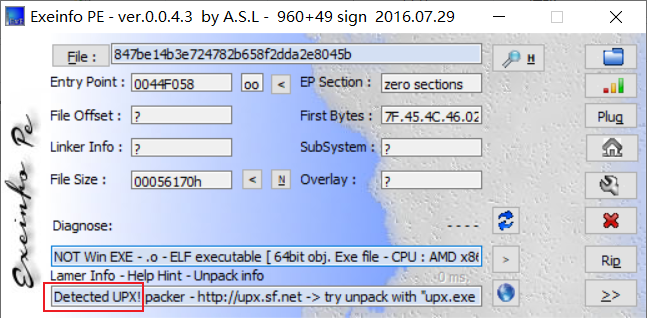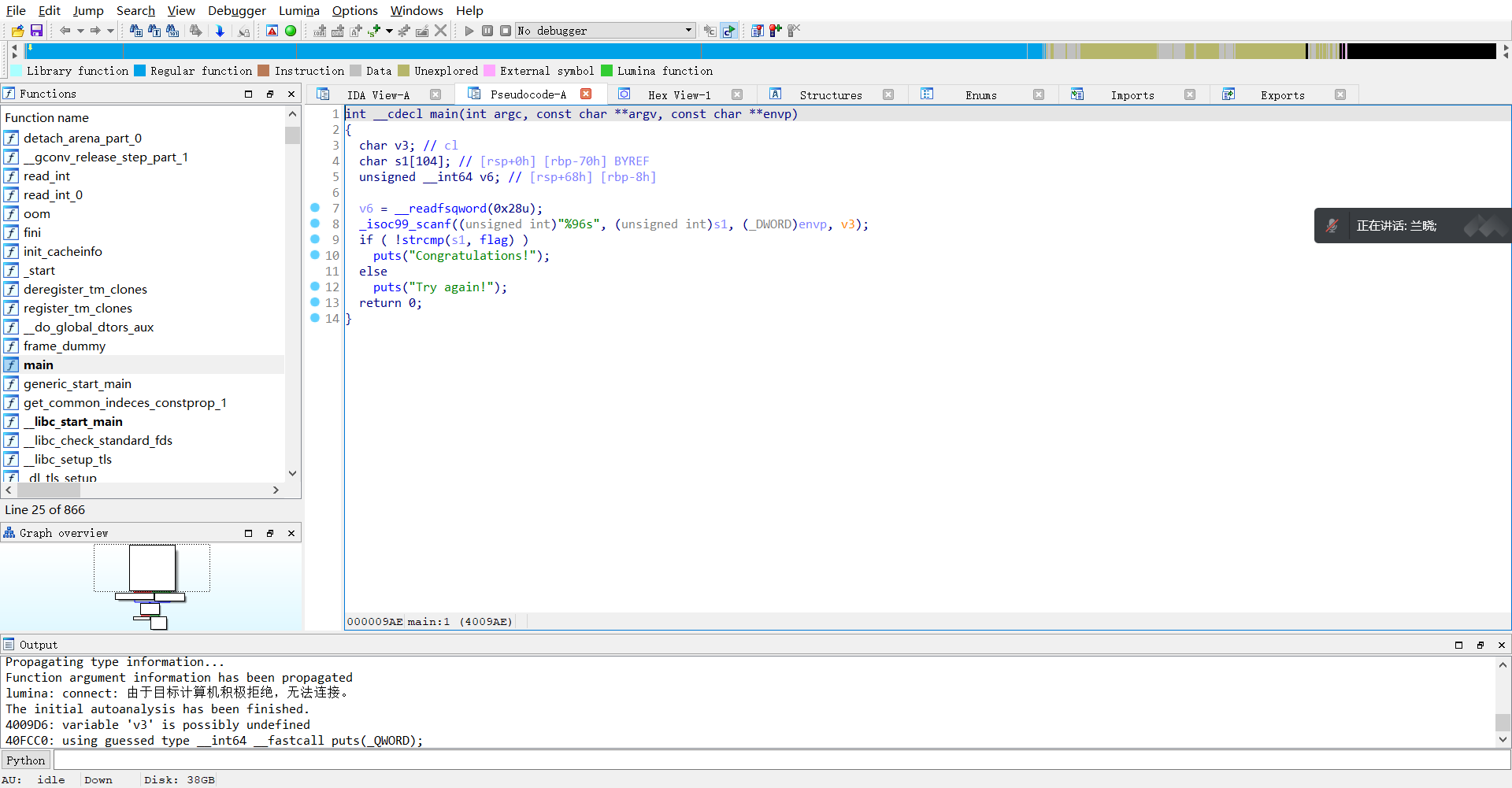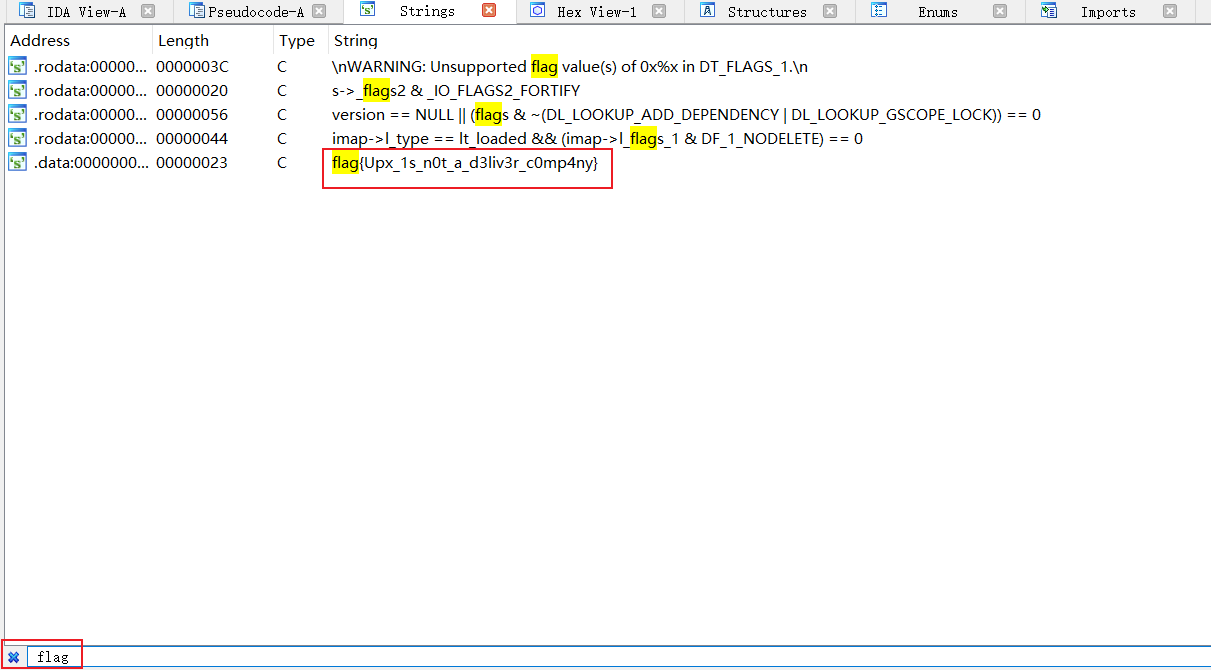Loading... # Reverse(三) ## 1. open-source ~~~C #include <stdio.h> #include <string.h> int main(int argc, char *argv[]) { if (argc != 4) { // argc代表输入数据数目 主要看下面argv[]里的分析 printf("what?\n"); exit(1); } unsigned int first = atoi(argv[1]); if (first != 0xcafe) { // first = 0xcafe(51966) printf("you are wrong, sorry.\n"); exit(2); } unsigned int second = atoi(argv[2]); if (second % 5 == 3 || second % 17 != 8) { // second模5不能等于3,模17等于8 即second%17=8 printf("ha, you won't get it!\n"); exit(3); } if (strcmp("h4cky0u", argv[3])) { // 长度为7 printf("so close, dude!\n"); exit(4); } printf("Brr wrrr grr\n"); unsigned int hash = first * 31337 + (second % 17) * 11 + strlen(argv[3]) - 1615810207; printf("Get your key: "); printf("%x\n", hash); return 0; } ~~~ 改写下 ~~~C #include<stdio.h> int main() { unsigned int hash = 0xcafe * 31337 + 8 * 11 + 7 - 1615810207; printf("Get your key: "); printf("%x\n", hash); return 0; } ~~~  得到flag ## 2. simple-unpack  有upx壳 upx脱壳 使用upx -d “文件名”指令  拖到ida64找到main函数  shift+F12查找字符串flag  找到flag ## 3. logmein ida64查看伪代码 转换后 ~~~C #include<stdio.h> int main() { char v8[]=":\"AL_RT^L*.?+6/46"; int v6 = 7; printf("Welcome to the RC3 secure password guesser.\n"); printf("To continue, you must enter the correct password.\n"); printf("Enter your guess: "); char s[100]; scanf("%32s", &s); int v3 = strlen(s); if ( v3 < strlen(v8) ) // 输入长度小于18 printf("incorrect!"); // 错误 for (int i = 0; i < strlen(s); ++i ) { if ( i >= strlen(v8) ) // i大于等于18 printf("incorrect!"); if ( s[i] != (char)(v8[i % v6 - 8] ^ v8[i]) )// 这里在查询了wp后才知道应该是v7,反编译错误了 // 别人反编译的是这样的 s[i] != (char)(*((_BYTE *)&v7 + i % v6) ^ v8[i] printf("incorrect!"); } printf("correct!"); // 正确 } ~~~ 主要在这句话上判断 ~~~c if ( s[i] != (char)(v7[i % v6] ^ v8[i]) ) printf("incorrect!"); ~~~ 对v7右键转换成char类型,得到v7 = 'ebmarah'; 注意需要**逆转字符串**,原因:x86系列的CPU都是以小端序储存数据的,即低位字节存入低地址,高位字节存入高地址 即 v7 = 'harambe' ~~~C #include<stdio.h> #include<string.h> #define BYTE unsigned char int main() { char v7[7] = "harambe"; char v8[18] = ":\"AL_RT^L*.?+6/46"; char s[18] = ""; for (int i = 0; i < strlen(v8); i++) { s[i] = (char)(*((BYTE *)&v7 + i % 7) ^ v8[i]); } printf("%s", s); } ~~~ 得到 RC3-2016-XORISGUD ## 小结 UPX一款先进的可执行程序文件压缩器 [UPX: the Ultimate Packer for eXecutables - Homepage](https://upx.github.io/) 最后修改:2023 年 12 月 14 日 © 允许规范转载 打赏 赞赏作者 支付宝微信 赞 如果觉得我的文章对你有用,请随意赞赏